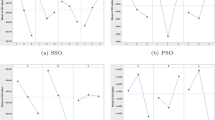Abstract
This paper considers scheduling problems where jobs are dispatched in batches. The objective is to minimize the sum of the completion times of the batches. While a machine can process only one job at a time, multiple machines can simultaneously process jobs in a batch. This simple environment has a variety of real world applications such as part kitting and customer order scheduling.
A heuristic is presented for the parallel machine version of the problem. Also, a tight worst case bound on the relative error is found. For the case of two parallel machines, we examine two heuristics, which are based on simple scheduling rules. We find tight worst case bounds of 6/5 and 9/7 on the relative error and show that neither procedure is superior for all instances. Finally, we empirically evaluate these two heuristics. For large problems, the methods find solutions that are close to optimal.
Similar content being viewed by others
References
Baker, K. R. “Scheduling the production of components at a common facility,”IIE Trans., 20, 32–35 (1988).
Blocher, J. D. and D. Chhajed, “The customer order lead time problem on parallel machines,”Naval Res. Logist., 43, 629–654 (1996).
Blocher, J. D. D. Chhajed and M. Leung “Customer order scheduling in a general job shop environment,”Dec. Sci., 29, 951–981 (1998).
Coffman, E. G. A. Nozari and M. Yannakakis “Optimal scheduling of products with two subassemblies on a single machine,”Opns. Res., 37, 426–436 (1989).
Daganzo, C. F. “The crane scheduling problem,”Transpn. Res.-B, 23B, 159–175 1989
Gerodimos, A. E. C. A. Glass and C. N. Potts “Scheduling the production of two-component jobs on a single machine,”Euro. J. Opnl. Res., 120, 250–259 (2000).
Graham, R. L. “Bounds for certain multiprocess anomalies,”Bell Sys. Tech. J., 45, 1563–1581 (1966).
Graham, R. L. “Bounds on multiprocessing timing anomalies,’ SIAM J. Appl. Math., 17, 416–429 (1969).
Graham, R. L. E. L. Lawler J. K. Lenstra andA. H. G. Rinnooy Kan “Optimization and approximation in deterministic machine scheduling: A survey,”Ann. Disc. Math., 5, 287–326 (1979).
Gupta, J. N. D. J. C. Ho and A. A. van der Veen “Single machine hierarchical scheduling with customer orders and multiple job classes,”Ann. Oper. Res., 70, 127–143 (1997).
Jordan, C. Batching and Scheduling: Models and Methods for Several Problem Classes, Springer, New York, 1996.
Julien, F. M. and M. J. Magazine “Scheduling customer orders: An alternative production scheduling approach,”J. Mfg. Oper. Mgt., 3, 177–199 (1990).
Peterkofsky, R. L. and C. F. Daganzo, “A branch and bound solution method for the crane scheduling problem,”Transpn. Res.-B, 24B, 159–172 (1990).
Potts, C. N. and L. N. Van Wassenhove “Integrating scheduling with batching and lot-sizing: A review of algorithm and complexity,”J. Opnl. Res. Soc., 43, 395–406 (1992).
Santos, C. and M. Magazine “Batching in single operation manufacturing systems,”OR Lett., 4, 99–103 (1985).
Vickson, R. G. M. J. Magazine and C. A. Santos “Batching and sequencing of components at a single facility,”IIE Trans., 25, 65–70 (1993).
Webster, C. and K. R. Baker “Scheduling groups of jobs on a single machine,”Opns. Res., 43, 692–703 (1995).
Author information
Authors and Affiliations
Corresponding author
Rights and permissions
About this article
Cite this article
Yang, J., Posner, M.E. Scheduling Parallel Machines for the Customer Order Problem. J Sched 8, 49–74 (2005). https://doi.org/10.1007/s10951-005-5315-5
Issue Date:
DOI: https://doi.org/10.1007/s10951-005-5315-5




